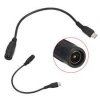wkearney99
Senior Member
For giggles I've been noodling around with a couple of Raspberry Pi 3 units. I recently came across a nice case designed for using a touchscreen in a tabletop sort of situation.
This 7" touchscreen:
http://www.microcenter.com/product/454804/7_Pi_Touchscreen_LCD_Display
In this case: (but also available in black)
http://www.microcenter.com/product/462657/Raspberry_Pi_Touchscreen_Case_-_White
The only downside is the way the Pi are laid out the power connector ends up being on top of the back of that case. I ordered a right-angle microUSB cord for it:
http://www.amazon.com/StarTech-com-Micro-Cable-Black-USBAUB2MD/dp/B00EBGGXS2
Now, with gizmos like amazon's Fire 7 tablets hitting the market at $69 it's not exactly a 'bargain' to go assembling a Pi setup like this. But there's the expansion and software options to consider and the Pi ecosystem is pretty robust on these fronts.
Fwiw, there's also a clever (if pricey) Media Pi+ case that makes for a nice HTPC-oriented enclosure. Much nicer having it all packed into one box, with an actual on/off switch, instead of a bunch of separate Pi-sized cases.
Anyway, just thought I'd share.
This 7" touchscreen:
http://www.microcenter.com/product/454804/7_Pi_Touchscreen_LCD_Display
In this case: (but also available in black)
http://www.microcenter.com/product/462657/Raspberry_Pi_Touchscreen_Case_-_White
The only downside is the way the Pi are laid out the power connector ends up being on top of the back of that case. I ordered a right-angle microUSB cord for it:
http://www.amazon.com/StarTech-com-Micro-Cable-Black-USBAUB2MD/dp/B00EBGGXS2
Now, with gizmos like amazon's Fire 7 tablets hitting the market at $69 it's not exactly a 'bargain' to go assembling a Pi setup like this. But there's the expansion and software options to consider and the Pi ecosystem is pretty robust on these fronts.
Fwiw, there's also a clever (if pricey) Media Pi+ case that makes for a nice HTPC-oriented enclosure. Much nicer having it all packed into one box, with an actual on/off switch, instead of a bunch of separate Pi-sized cases.
Anyway, just thought I'd share.



